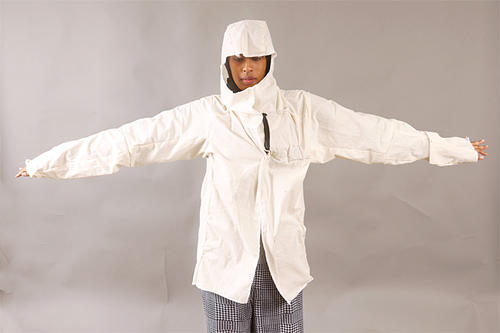
Every spring, College of Design students in the apparel design program select from a series of project requests for the annual NASA research symposium. While NASA provides most of the design requests, some come from businesses like outdoor clothing company Patagonia, whose proposal caught the attention of apparel design majors Ian Harris, Warda Moosa, and Mary Xiong.
Patagonia tasked students with creating an emergency avalanche transceiver garment that could boost an emergency beacon’s signal for backcountry winter sport use.
“I’m pretty sure the only thing I have done remotely close to [outdoor winter sports] is going tubing,” says Harris. “But, as a Minnesotan, I do have a good understanding of winter, so that made me interested in what type of fabrics and materials we could use.”
To meet Patagonia’s specifications, the students focused on four research initiatives: strategically placing the emergency beacon, limiting interference to the beacon signal, securing the beacon, and maintaining user mobility. In her research, Moosa sourced an electromagnetic-field (EMF)-shielding fabric that blocks signals that may interfere with a broadcast beacon.
The group then tested potential signal interference by placing a phone running an app between various layers of the fabric and recording the results.
“I wanted to test the different layers to see if there was a relationship between the number of layers and the amount of cell signal blocked by the fabric,” says Moosa.
Testing revealed that the more layers of an EMF shielding fabric with copper and nickel coated fibers, the less interference there was with the beacon signal.
“I don’t think I would have ever sought out that type of fabric to help limit the interference with the beacon signal. Using it was what helped us stand out when we submitted the project,” says Harris.
The students also tested placement of the beacon for comfort.
The final prototype, a jacket shell, features a designated avalanche beacon pocket on the upper left area of the front chest, while the inside includes an integrated harness system to keep the beacon and jacket secure.
Thinking they had something, the students submitted their project to the Industrial Fabrics Association International (IFAI) Advanced Textiles Student Design Competition.
“We didn’t think much of it for the rest of the summer until we all received an email notifying us of our win,” says Harris.
The three-member team recently went to Orlando to present their project at the annual IFAI Expo and met with professionals in the industrial fabrics industry.
Patagonia will now decide if it wants to implement any of the group’s design decisions.
-------
This story was adapted from the College of Design.
- Categories:
- Architecture and Design




